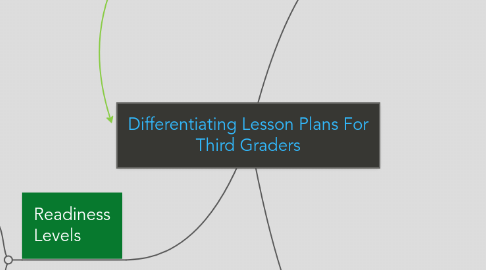
1. Readiness Levels
1.1. Tia has high academic performance
1.1.1. Teaching strategy #1: Ask Tia if she'd like to research and find a folktale from another country. Have a few chosen Internet links for her to check out about folktales from other lands. It could be one from her heritage or one that she has an interest in. Allow her to present it to the class and point out three key differences or similarities.
1.1.2. Teaching strategy #2: Ask Tia how she would have changed the story? Ask her to change one of the 5 Ws to change the story. If it had a different "when" or "where," how would that change the scope or feel of the story?
1.2. Robert has behavioral challenges
1.2.1. Teaching strategy #1: At the beginning of the day, let the class have a rough idea of what's coming, including the telling of the folktale. For Robert, this will give him a chance to prepare and not be sprung into an activity where he needs to be respectful and calm. To get there, don't have a busy activity right before the folktale lesson. I'd have it a little later in the afternoon, not right after lunch but perhaps the second activity. It will help keep the entire class calm.
1.2.2. Teaching strategy #2: Ask Robert if he'd like to hold the book for you as you read and have him show any pictures to the class, as you go along. Ask him privately, first. Tell him that you'll be having him lead off the discussion after reading the book by saying what his favorite part of the book was. When he starts any written assignment, go to his desk and help him get a start and thank him for helping to lead the class.
2. Objective: Deconstructing a folk tale: Read or tell a folktale to the class. The students will be asked to listen carefully to the tale so that they can answer questions about what they heard. The goal is to be able to answer the following: Who: Name the main characters. What: Describe an action that one character did in the tale. Where: Describe a detail that you heard that refers to where the tale was set. When: Explain the sequence of events by describing part of its timeline.
3. Interests
3.1. Student 1: Bess favors adapting her Musical Intelligence in activiities
3.1.1. Teaching strategy #1: Allow Bess - and anyone else who wants to - Pick a few lines from the folktale and create a short song that focuses on the Who or the What or Where etc.
3.1.2. Teaching strategy #2: Ask Bess to think about the rhythm of the words in the folktale and have her (and anyone else) choose words in the story that have the same pattern or sound. Have her discuss why using such word detail can make the story more pleasant to hear.
3.2. Student 2: Manuel favors using Bodily-kinesthetic intelligence for lessons
3.2.1. Teaching strategy #1: Have Manuel give (perhaps even lead) an activity that tells the folktale in body language. He could study the written word and create movements to act out the tale. Attention would be put on having him act out detail.
3.2.2. Teaching Strategy #2: Teach Manuel and others a few words in sign language by going online and watching lessons for beginners. Help them learn to sign a few words from the story. They could then use the words they've used to sign as much of a folktale as they can on their own. Video their creations.
4. Learning Profiles
4.1. Student #1: Angela has ADHD
4.1.1. Teaching strategy #1: Allow Angela to pick where she'd like to sit during the telling of the folktale. She might want to sit ahead of the others, so she is not bothered my any movement, which would distract her. Or, she might want to sit in the back, not feeling she has to "perform" or be in the spotlight, by being in the front.
4.1.2. Teaching strategy #2: Because ADHD students may need to move about, have cut out shapes of the 5 Ws and How, to let her hold. You can let her pick one of the shapes to hold up, asking her to explain one other 5 Ws or the How she heard in the story.
4.2. Student #2: Carmen is an ELL student
4.2.1. Teaching strategy #1: Try to find a folktale that might have a rich cultural base. In whatever writing assignment is given, ask Carmen and others from different cultures if there is a version of the folktale in their heritage. Does it have the same message or does it end differently?
4.2.2. Teaching strategy #2: Have the ELL students (and anyone else) create a map of the story on an iPad. Have them create a story sequence as to "this happened, then this" etc., all the while having them highlight the 5 Ws and How in different colors. This can help Carmen and others feel grounded, as they make sense of the folktale.
